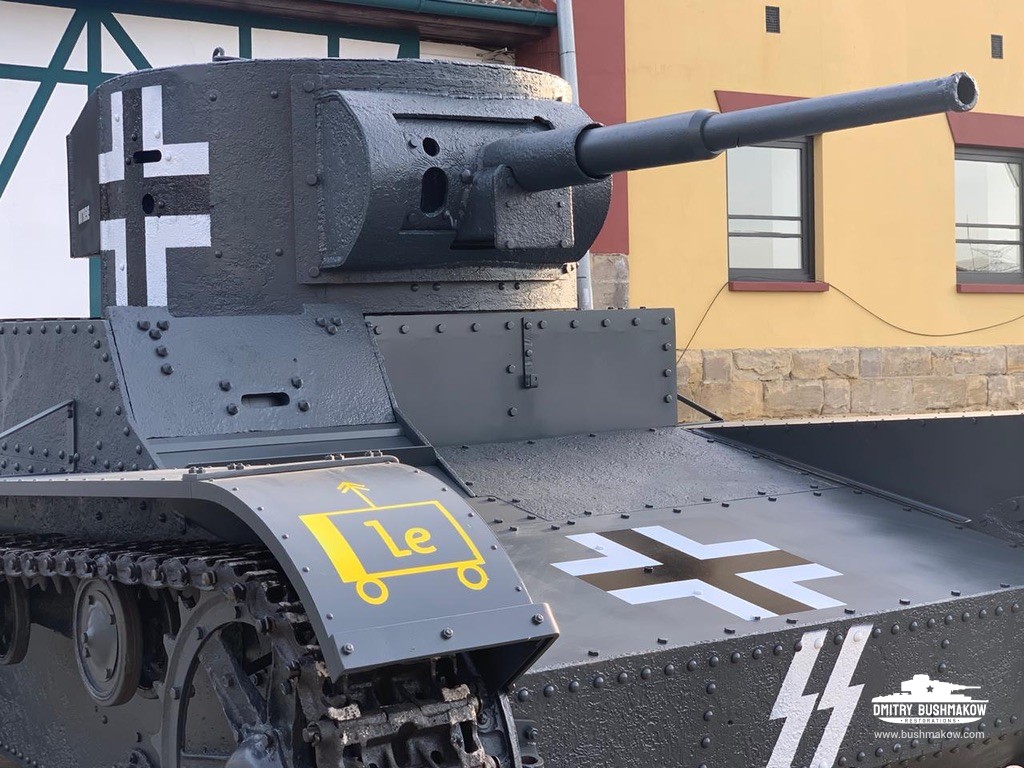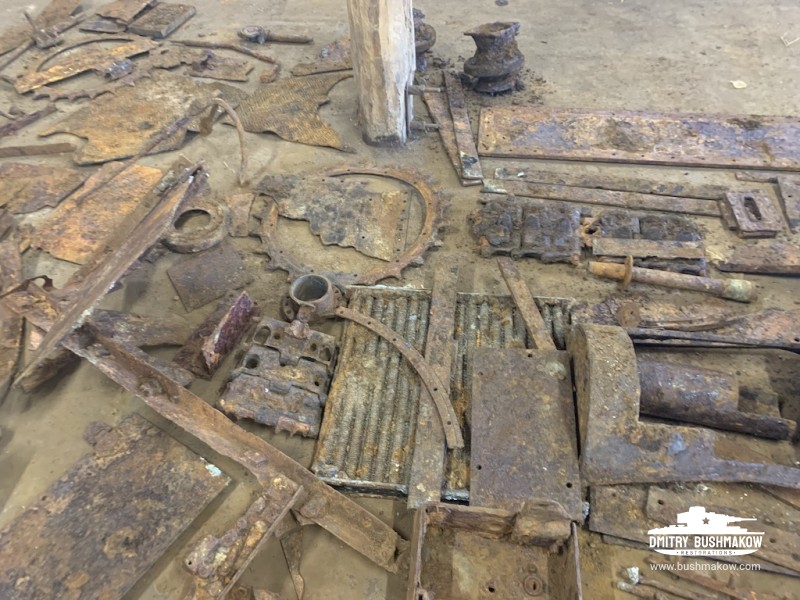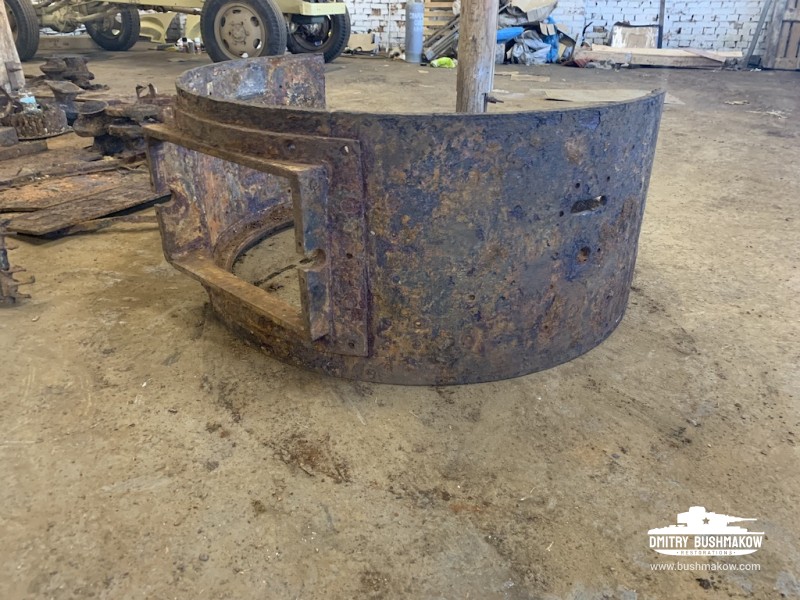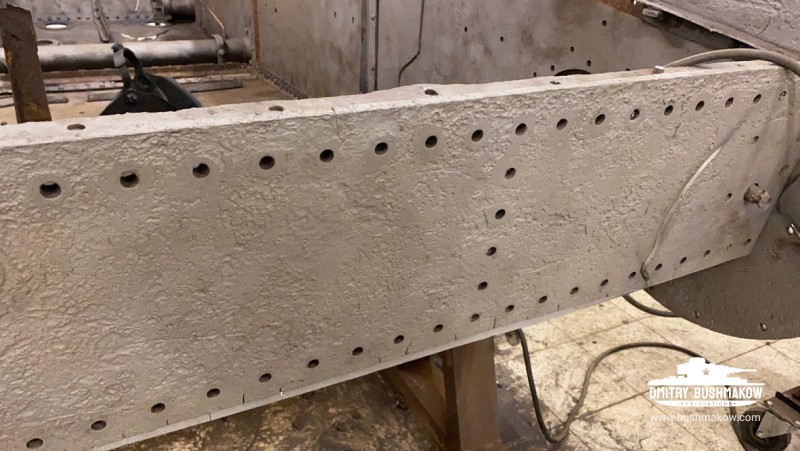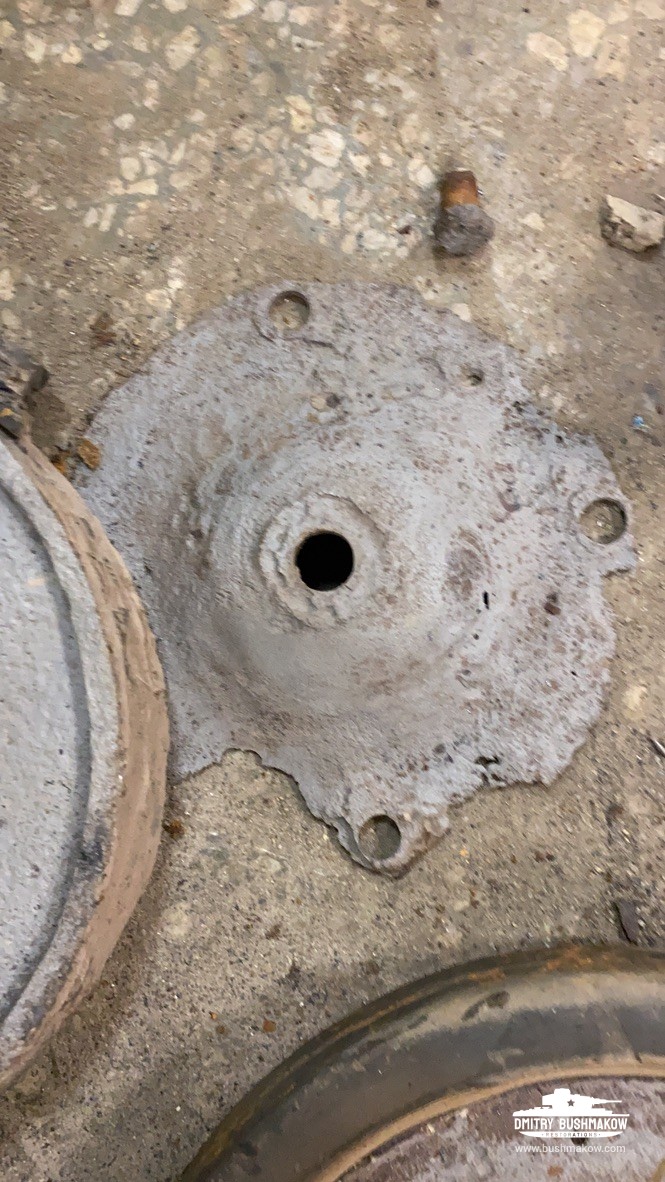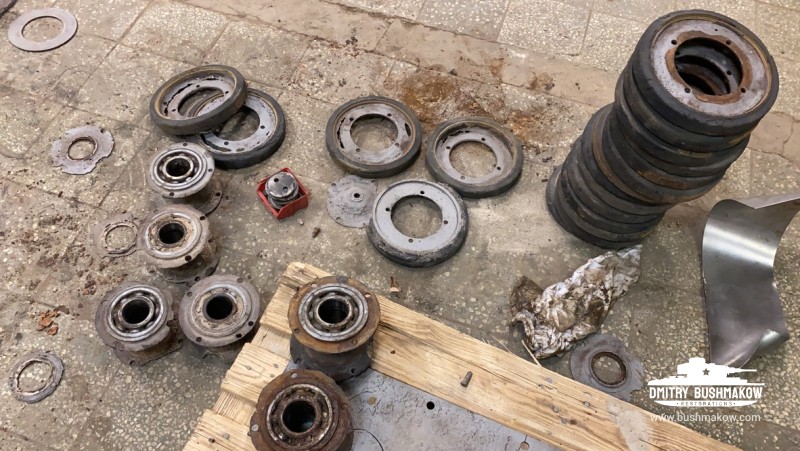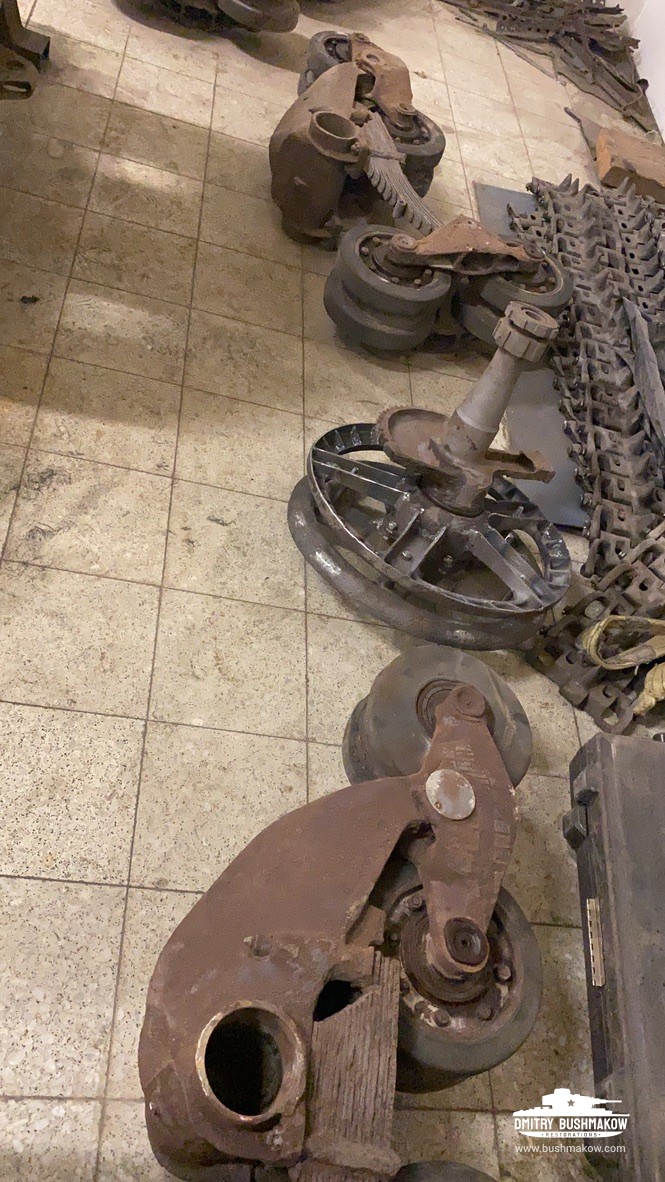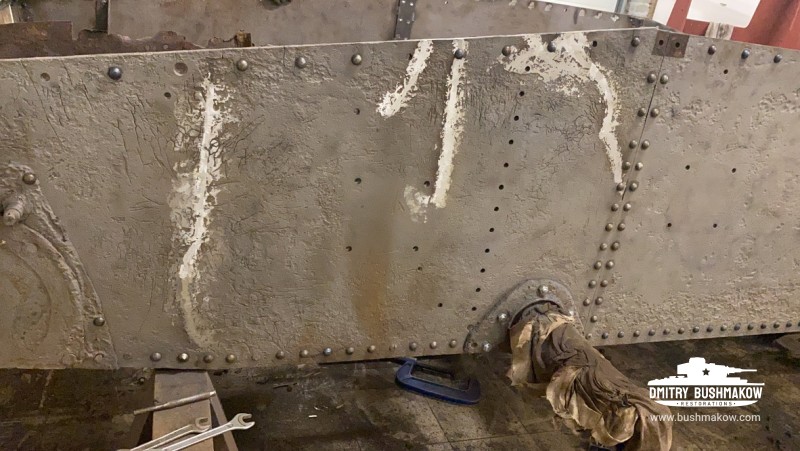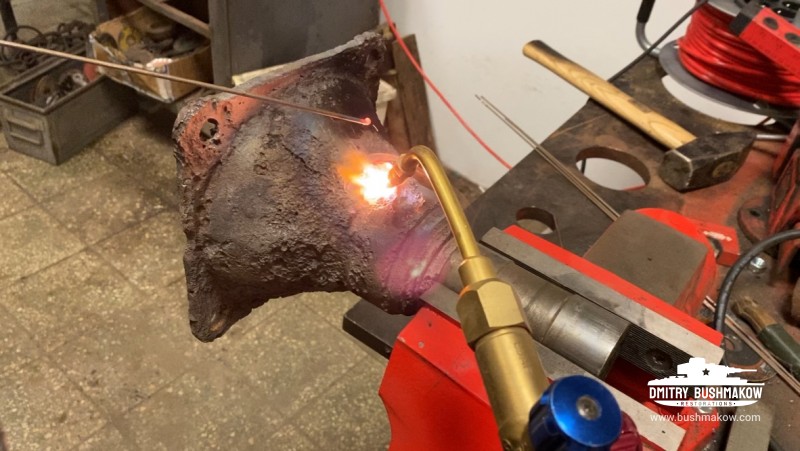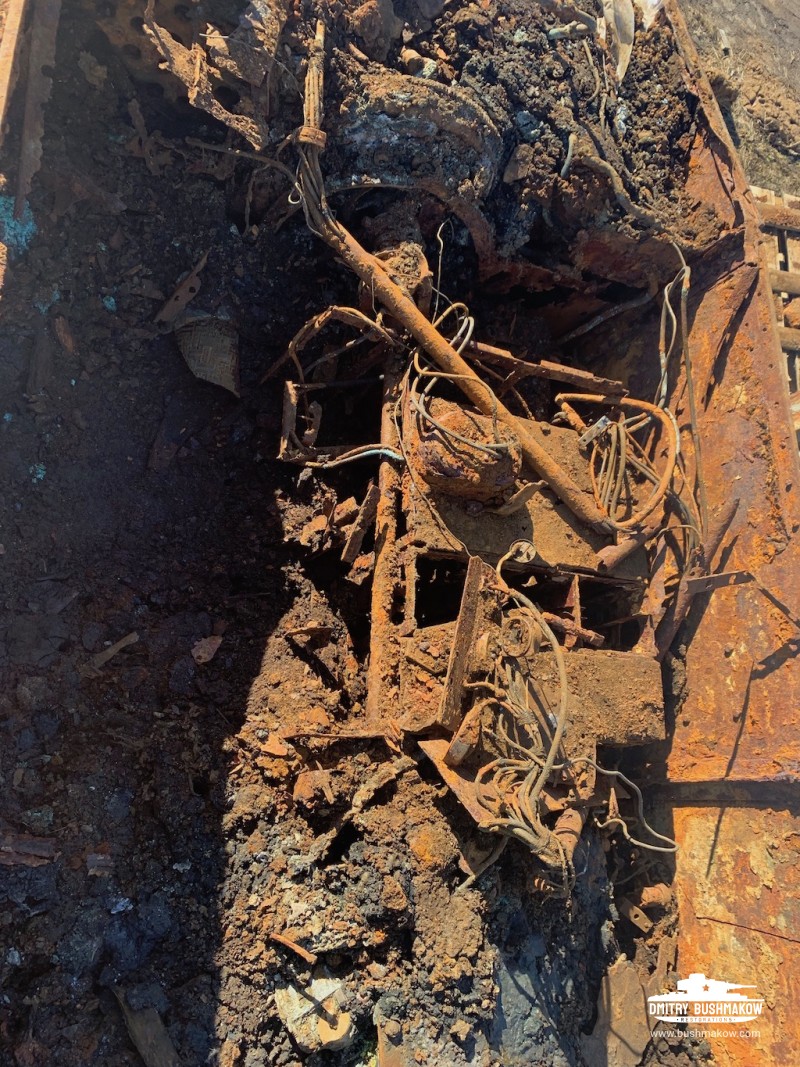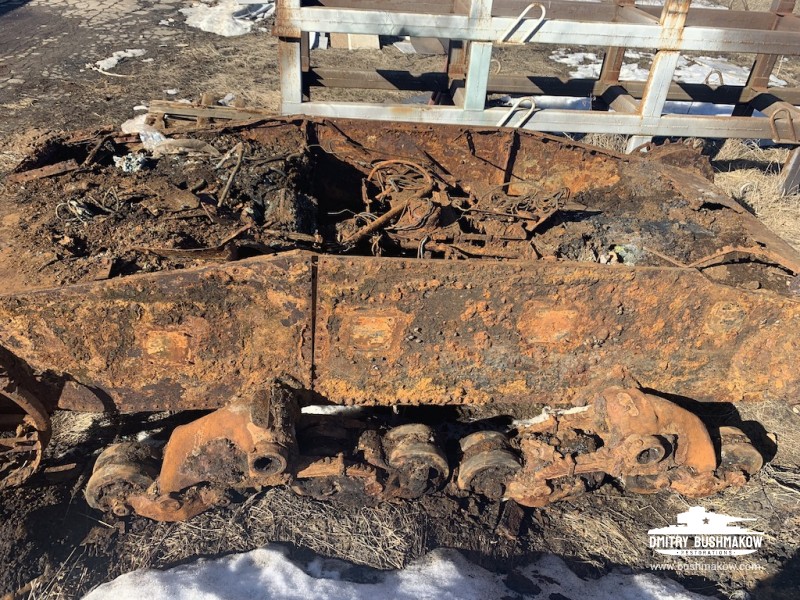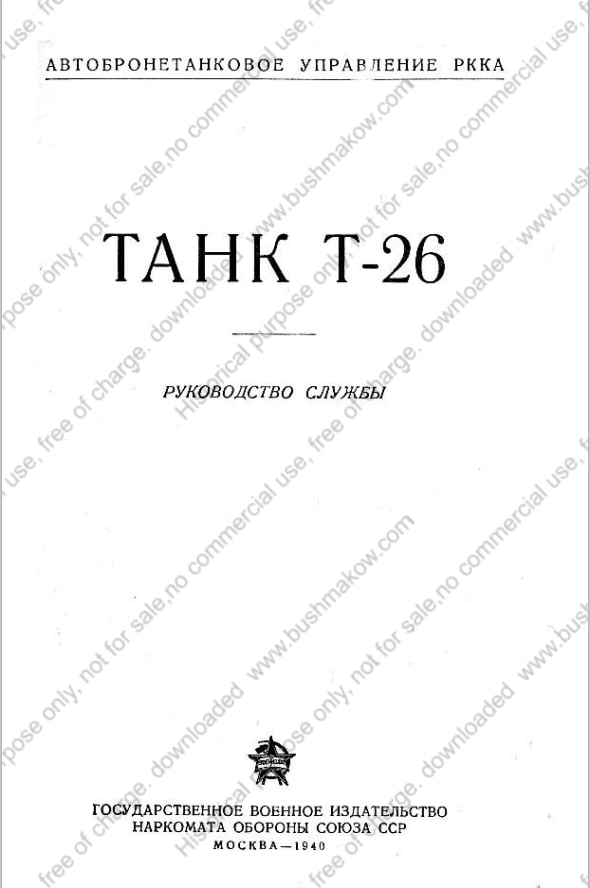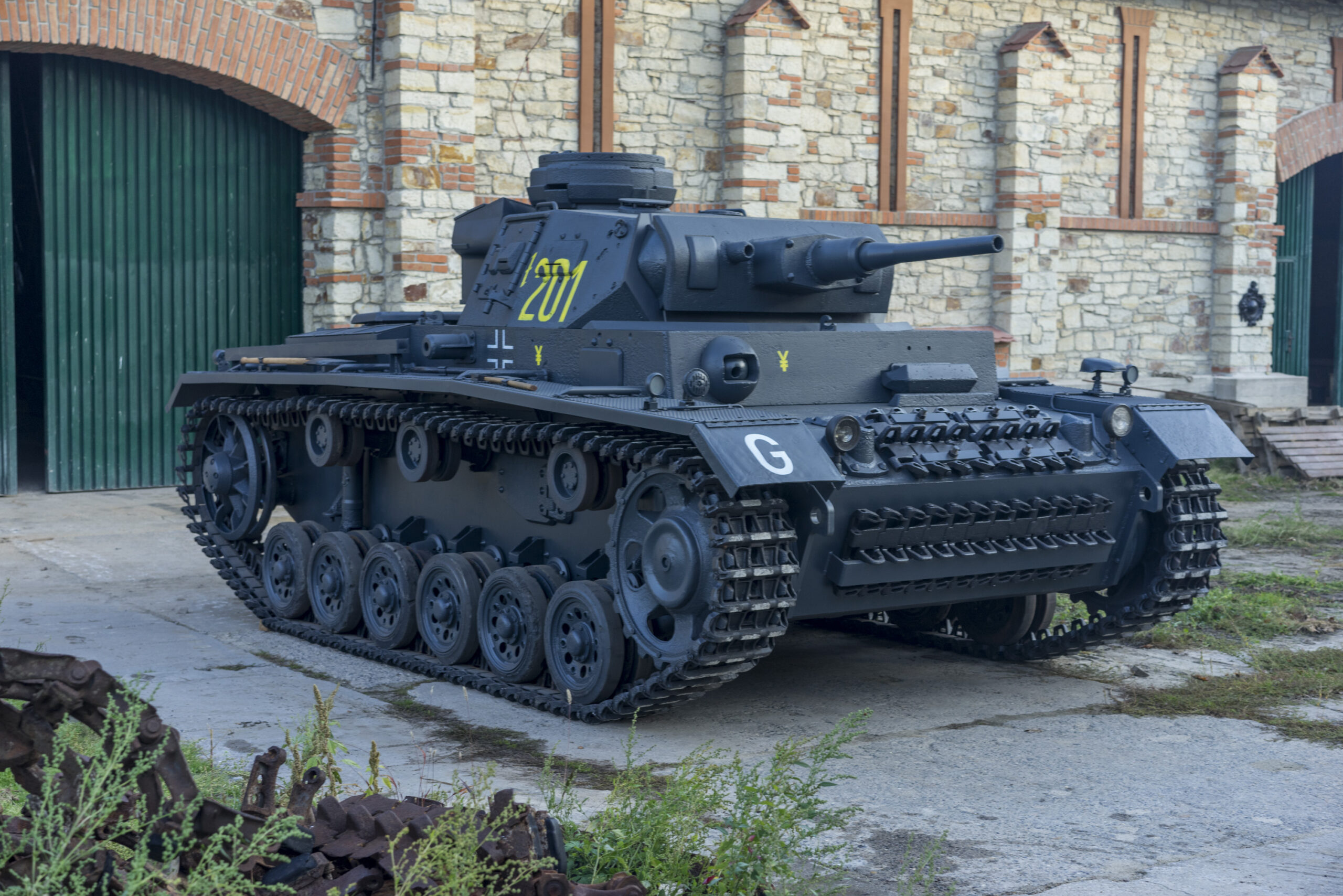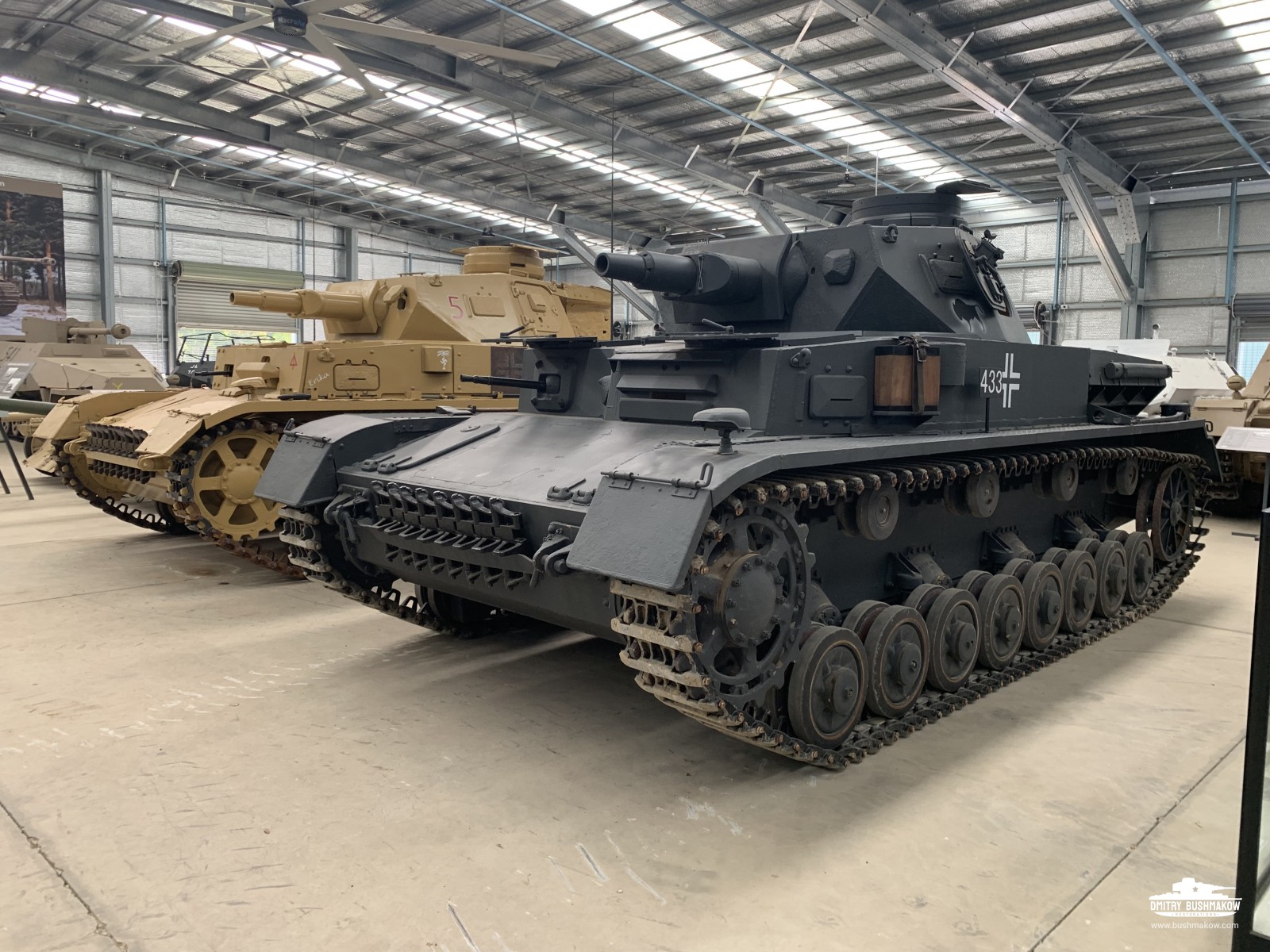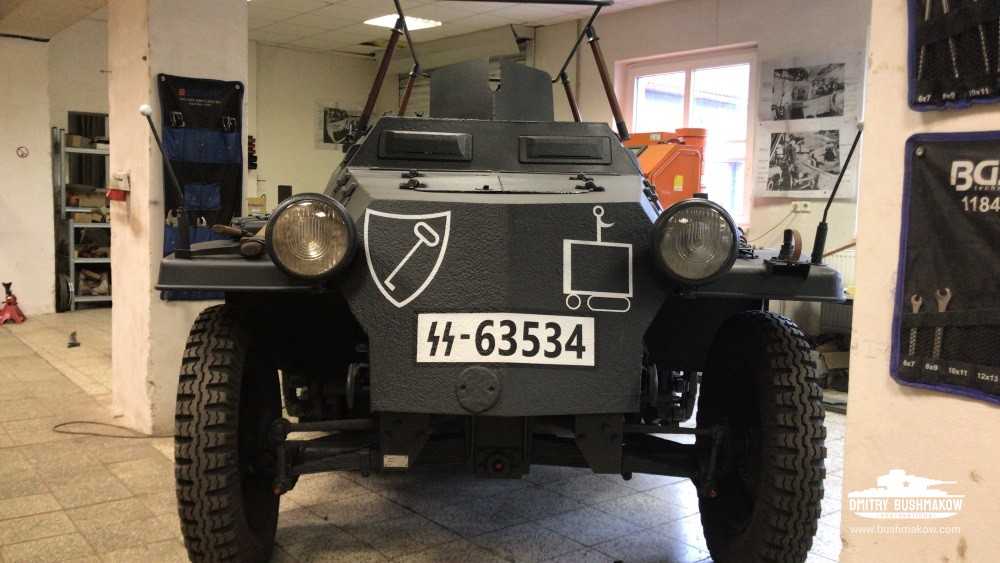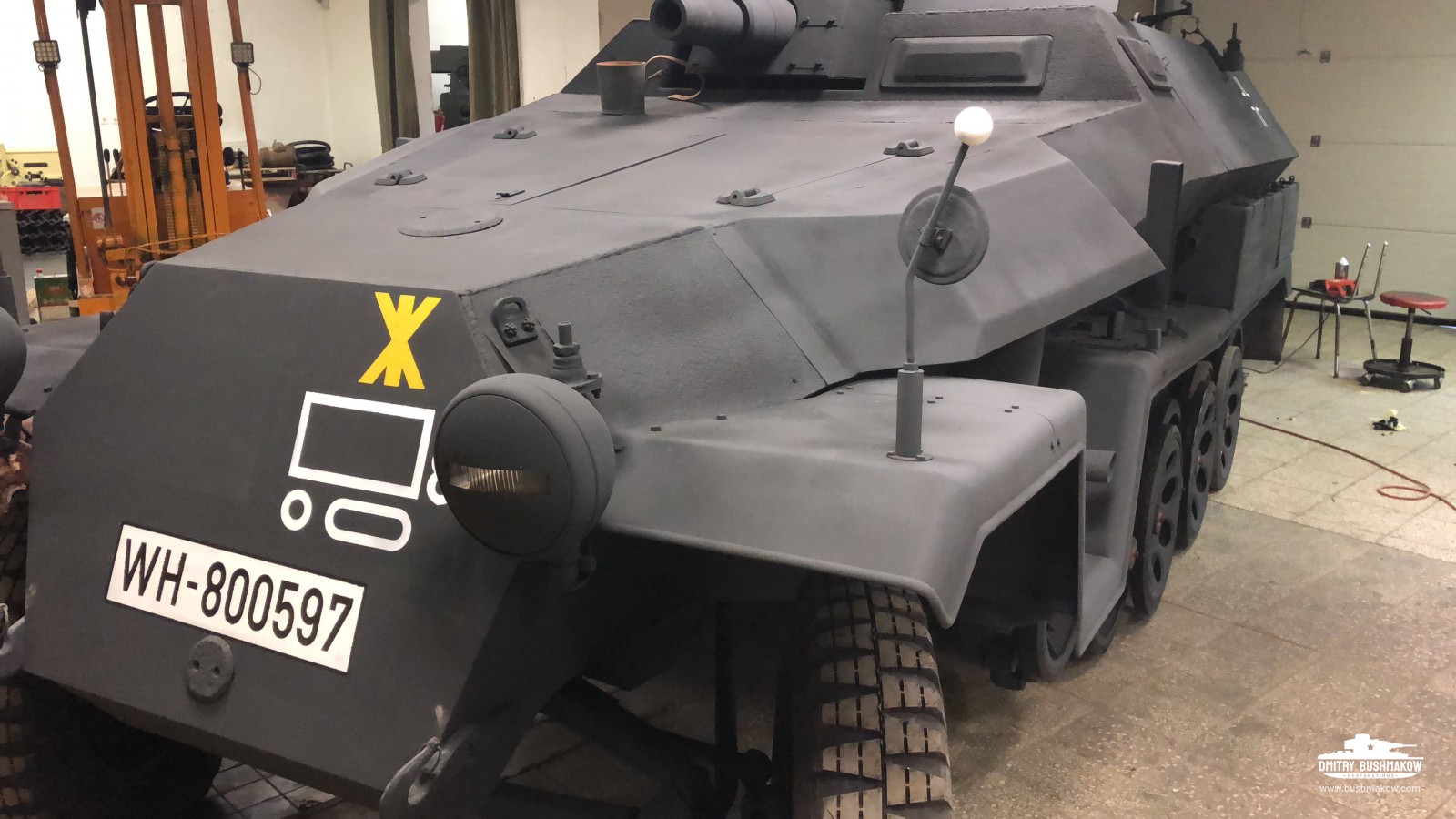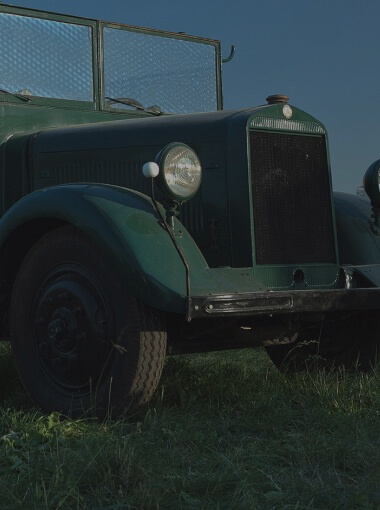

This tank comes from a war, was lost in a water, and has no any rests of paint, which gave us no historical frames to make it under certain formation or color scheme. T-26 Mistbiene painted with soviet color and stars, and overpainted with Totenkopf tacticals based on original photos. A large number of captured T-26 tanks were used in the Wehrmacht and Waffen-SS, and later in volunteer and police formations for anti-partisan warfare away from the front lines. Tank T-26 from the third SS division Totenkopf (dead head) with the unit emblem on the wing of the tank and SS runes on the front sheet, the tank with huge German crosses on the tower and the top sheet (for aviation) bears its own name «Mistbiene» — foggy bee T -26 from 3 SS in Lewschkowo.
08/30/1941 SS-totenkopf left many photographical evidence of trophy vehicles in its colors starting from Pahnard AMD 178 in French campain 1940, and in Soviet Union, they used many trophy soviet vehicles including even Knight cross winners with T-34/76
T-26 is one of Vickers-Armstrong variants of the Mk.E for serial production under license in the USSR in 1931, a two-turret machine gun was selected, in fact, work on a single-turret T-26 began in 1932. the first turret of this type, created by the Izhora plant by the spring of 1932 and intended for the BT-2 tank, had a cylindrical shape and was supposed to be installed on the T-26 fighter tank variant with the addition of a niche in the back for installing a radio station. To conduct military trials, the Izhora plant was supposed to produce a batch of 10 turrets from January 21, 1933. The production of a single-turret tank was to start with the 1601 serial T-26. No difficulties with the transition to a single-turret tank were expected and it was planned to start production in the spring of 1933, but due to delays in the supply of guns and optical sights, it was started in the summer.
The problem was the T-26 engine, which at that time was 85-88 hp. with., seemed insufficient due to the increased mass of the tank, with the transition to a single-turret modification, increased by another 1 ton. In the fall of 1932, the Vickers-Armstrong company offered the Soviet side its modernized version of the 100 hp engine, but the USSR refused, The satisfactory operation of the engine was achieved in May 1933 with a power of 92 hp. Since 1933, other engines were developed, but their production was never started, although the engine compartment of the tank from 1934 was slightly modified to allow the installation of a diesel engine. Also, one running original tank in the Patriot Park has a diesel engine.
The 45 mm cannon, with frequent firing, created an unacceptable concentration of gas and smoke in the crew compartment of a tank; in 1934, a fan was put on the right side of the roof of the fighting compartment (it is not on early tanks). In 1935-1936, the transition to welded hulls was made, the welded mask of the gun was replaced with a stamped one in 1935. Of the measures to increase mobility, it was possible to carry out only an increase in the range by placing an additional fuel tank in the engine compartment. From the end of 1935, an additional ball mount with a DT-29 machine gun in the rear of the turret began to be installed on the T-26, and some of the machine guns began to be equipped with optical sights. At the end of 1935, the DT-29 anti-aircraft machine gun mount was developed for the tank. In addition, since 1935, at the rate of every fifth tank, the T-26 for warfare at night began to be equipped with two headlights-searchlights fixed on the gun mask — the so-called «combat light».
Total Production of T-26 single turret tanks by No. 174 Bolshevik factory 1933-1941:
Red Army 8009 tanks
Red Navy 23 tanks
Turkey 64
** 74 of them were converted into TT-26 and TU-26 (37 groups). remote controlled tanks
*** One of them was converted into TU-132.
Total Production of T-26 single turret tanks by STZ (Stalingrad Tractor Plant) factory 1934-1940:
Red Army 249
Red Navy 53
* According to the plant «Bolshevik» — 17, RGAE — 19; TMM-1 and TMM-2 may not have been / were considered.
In addition, at the beginning of 1941, 130 two-turret tanks were converted into single-turreted ones by installing on them towers from the HT-133, but with a 45-mm gun.
«Annual report of plant No. 174 for 1941 (Leningrad branch)»
«Since the beginning of the reporting year, we have produced:
Manufacturing and alteration of circles and towers of machine 133 for linear T-26 — 130 «.
That is, a total of 76 tanks were manufactured for the coastal units of the RKVMF (Workers ‘and Peasants’ Navy). The main armament of the single-turret modifications was a powerful 45-mm rifled semi-automatic cannon 20-K mod. 1932, and since 1934 — its modified version of arr. 1932/34 ] The gun had a barrel length of 46 calibers / 2070 mm, a vertical wedge gate with a semiautomatic mechanical type on the gun mod. 1932 and inertial type on arr. 1932/34 Semi-automatic guns mod. 1932/34 it worked only when firing armor-piercing projectiles, while when firing fragmentation shells, due to the shorter recoil length, it worked like ¼ automation, providing only automatic shutter closing when a cartridge was inserted into it, while opening the shutter and extracting the sleeve was carried out manually. The practical rate of fire of the gun was 7-12 rounds per minute.
The cannon was based in a turret frontal mount paralleled with a DT machine gun. Aiming along the horizon was carried out by turning the turret using a rotary screw mechanism. The mechanism had two gears, the rotation speed of the turret on which for one switch of the gunner’s flywheel was 2 or 4 °. Vertical guidance, with maximum angles from −6 to + 22 °, was carried out using a sector mechanism. Guidance was carried out using a panoramic periscopic optical sight PT-1 mod. 1932 and telescopic optical sight TOP, model 1930 [64] PT-1 had an increase of 2.5 × and a field of view of 26 °, and its reticle was designed for firing at a range of up to 3.6 km with armor-piercing shells, 2.7 km with fragmentation shells, and up to 1.6 km with a coaxial machine gun. … For shooting at night and in low light conditions, the sight was supplied with illumination of scales and crosshairs of the sight. The TOP had an increase of 2.5 ×, a field of view of 15 °, and an aiming reticle designed for firing at a distance of up to 6.4, 3 and 1 km, respectively. Since 1938, a telescopic sight TOP-1 (TOS-1), stabilized in the vertical plane, with optical characteristics similar to the TOP was installed on some of the tanks. The sight was equipped with a collimator device, when the gun vibrated in the vertical plane, it automatically fired a shot when the position of the gun coincided with the aiming line. Cannon mod. 1934, adapted for use with a stabilized sight, was designated as arr. 1938 Due to the complexity of the use and training of gunners, the stabilized sight was removed from service by the beginning of World War II.
On some of the single-turret tanks produced, which received the designation T-26RT, a radio station of the 71-TK-1 model was installed in the autumn of 1933. The share of the RT-26 was determined by the volume of deliveries of radio stations, which were primarily equipped with the vehicles of unit commanders and some of the linear tanks. Since 1934, the upgraded version 71-TK-2 was adopted, and since 1935 — 71-TK-3. 71-TK-3 n The maximum communication range in the telephone mode was 15-18 km in motion and 25-30 km from the spot, in the telegraph mode — up to 40 km; in the presence of interference from the simultaneous operation of many radio stations, the communication range could be halved. For the internal communication between the tank commander and the driver on the tanks of the early releases, a communication pipe was used, later replaced by a light signaling device. Since 1937, tanks equipped with a radio station were equipped with a TPU-3 tank intercom for all crew members.
Spanish Civil War 1937
In total, 281 T-26 tanks were sent to Spain:
1936 — 106 units.
1937 — 150 pcs.
1938 — 25 units
On July 8, 1937, the head of the ABTU RKKA Divisional Commander Bokis signed another certificate on the property sent on July 17, 37:
Tank T-26 linear (without radio stations) with weapons and spare parts — 71,710 rubles. ($20 150 US dollars);
Tank T-26 with a radio station — 75 810 rubles. ($21,302 US);
Motor T-26 with the main clutch assembly, 11 380 rubles. ($3,198 US);
Gearbox for T-26 assembly — 4,700 rubles. ($1,320 US);
45-mm tank cannon — 7,000 rubles. ($2,100 US);
Periscope to the T-26 — 6100 rubles. ($2,000 US);
Radio station 71-TK — 10 for 1,850 rubles. ($555 US).
The world’s first tank Ram in 1936
During the Spanish Civil War, on October 29, 1936, Semyon Osadchiy in a T-26 tank made the world’s first tank ram, pushing the Italian Ansaldo tankette into a hollow.
The battles at Lake Hasan 1938
The first combat operation of the Red Army, in which the T-26 participated, was the Soviet-Japanese conflict near Lake Khasan in July 1938. To defeat the Japanese forces, the Soviet command attracted the 2nd mechanized brigade and the 32nd 40th separate tank battalions of the 32nd and 40th rifle divisions. The Soviet tank group numbered 257 T-26s, including 10 HT-26s, three ST-26 tank bridges, 81 BT-5s and BT-7s, and 13 SU-5-2 self-propelled guns.
During the assault on the Japanese-occupied hills of Bogomolnaya and Zaozernaya, Soviet tankmen came across a well-planned anti-tank defense.
During the battles near Lake Khasan, 77 T-26s were lost, of which 1 XT-26 and 10 T-26 were irrevocably lost, and one T-26 out of the 40th checkpoint, missing in enemy territory, was never found. After the end of the fighting, 39 tanks were restored by the forces of military units, the rest required factory repair.
Battle on Khalkhin Gol 1939
The main brunt of the fighting in Mongolia near the Khalkhin-Gol River fell on BT tanks. By February 1, 1939, in the 57th Special Corps in Mongolia, there were only 33 T-26 tanks, 18 HT-26s and 6 tractors based on the T-26. BT-5 and BT-7 were 219. So, on July 20, 39, in units of the 1st army group, there were 10 HT-26 tanks (11th light tank brigade) and 14 T-26 (82nd rifle division). By August, the number of T-26s, mainly flamethrower-chemical, had increased — the chemical was 37, but still they made up a small part of the tanks participating in the battles. However, they were used quite extensively.
In the documents of the 1st Army Group, it was noted that “the T-26 showed themselves exceptionally well, they crossed the dunes well, the tank had great survivability. In the 82nd division, there was a case when the T-26 had 5 hits from a 37mm gun, destroyed the armor, but the tank did not catch fire and after the battle it came to the assembly point of emergency vehicles on its own. After such a flattering assessment, a much less flattering conclusion follows, concerning the T-26’s reservation: «The Japanese 37-mm cannon penetrates the armor of any of our tanks freely.»
A special assessment was given to the actions of chemical tanks.
“By the beginning of hostilities, the 57th Special Corps had only 11 chemical tanks (HT-26) in the combat support company of the 11th light tank brigade. The flamethrower mixture had 3 charges in the company and 4 in the warehouse.
On July 20, the 2nd company of chemical tanks from the 2nd tank chemical brigade arrived in the combat area. She had 18 XT-130 and 10 charges of a flamethrower mixture. However, it turned out that the personnel had very little training for flamethrowing. Therefore, before the company reached the area of hostilities with personnel, practical exercises on flamethrowing were conducted and the combat experience already available from the tank chemists of the 11th LTBR was studied.
In addition, the 6th Tank Brigade that arrived at the front had 9 HT-26s. In total, by the beginning of August, the troops of the 1st Army Group had 19 HT-26, LHT-130 — 18 pcs.
During the period of the August operation (August 20-29), all chemical tanks took part in the battle. They were especially active during the period 23-26 August, and during these days LHT-130 went on the attack 6-11 times.
In total, during the conflict, chemical units used up 32,000 kg of flamethrower mixture. Losses in personnel amounted to 19 people (9 killed and 10 wounded).
The weak point of the use of flamethrower tanks was poor reconnaissance and preparation of vehicles for an attack. As a result, there was a large consumption of fire mixture in secondary areas and unnecessary losses.
During the very first battles, it was found that the Japanese infantry could not withstand flamethrowing and was afraid of a chemical tank. This was shown by the defeat of the Azum detachment on May 28-29, in which 5 HT-26s were actively used.
In subsequent battles, where flamethrower tanks were used, the Japanese invariably left their shelters, showing no stamina. For example, on July 12, a Japanese detachment as part of a reinforced company with 4 anti-tank guns penetrated deep into our location and, despite repeated attacks, offered stubborn resistance. Introduced only one khimtank, which gave a stream of fire at the center of resistance, caused panic in the enemy ranks, the Japanese fled from the front trench into the depths of the pit and our infantry arrived in time and occupied the crest of the pit, this detachment was finally destroyed.
In the battles near the Khalkhin-Gol River, 7 vehicles were irretrievably lost, of which 5 HT-26, 2 single-turret T-26
Polish campaign of the Red Army 1939
During the operation of september 1939 officially called by soviets as»liberation western Belarus and western Ukraine», 5 single-turret T-26 s were irretrievably lost.
Soviet-Finnish war 1939-1940
The most intensive use of tanks of this type was during the Soviet-Finnish war (1939-1940).
In the Winter War, the Red Army irrevocably lost 23 two-tower, 265 single-tower and 10 radio single-tower tanks.
Tanks T-26 were the most numerous in the Red Army at the beginning of the Great Patriotic War. In the very first months of the war, most of these tanks (along with tanks of other types) were lost due to the fact that 73% of the tanks of the old types required major or medium repairs.
As of October 28, 1941, there were 441 tanks on the Western Front, of which 33 KV-1, 175 T-34, 43 BT, 50 T-26, 113 T-40 and 32 T-60.
They were massively used during the Iranian operation (1941).
The last time the T-26 was used was in 1945 against the Japanese Kwantung Army in Manchuria.
In addition to the Red Army, 76 T-26s were part of the Workers ‘and Peasants’ Navy. In 1938, out of 23 vehicles produced by order of the department, 12 went to the Northern Fleet and 11 to the Pacific Ocean Fleet; out of 21 tanks delivered in 1939, 1 were shipped to the Red Banner Baltic Fleet and 20 from STZ — Pacific Fleet in 1940, out of 32 tanks, 22 entered the Red Banner Baltic Fleet (12 linear, 6 radium and 4 anti-aircraft) and 10 from STZ received the Pacific Fleet.
On June 1, 1941, there were 12 tanks in the Northern Fleet (a separate tank company), in the Baltic Fleet — 23 (in warehouses: 11 in Tallinn and 12 in Leningrad) and 41 in the Pacific Ocean Fleet (1st, 2nd, 4th I and the 351st separate tank companies, the latter being part of the 3rd separate rifle brigade of the Vladimir-Olginskaya Naval Brigade).
Tanks of the BT and T-26 series formed the basis of the Red Army tank fleet in the late 1930s. The armor protection of the T-26 was designed for maximum resistance to rifle bullets and shell fragments. At the same time, the armor of the T-26 was penetrated by armor-piercing rifle bullets from a distance of 50-100 m. Therefore, one of the directions of development of Soviet tank building was a radical increase in the armor protection of tanks from the fire of the most massive anti-tank weapons. Despite the weak armor protection, the tank was tenacious due to the fact that the engine and tanks were located in the aft compartment behind the enclosure. This tank had a record for that time ammunition — 230 37-mm shells, both armor-piercing and incendiary.
In 1933, the T-26 was a powerful and modern tank, but by 1938 the T-26 was still surpassing foreign vehicles in armament, and was inferior to them in other parameters. First of all, the weakness of the booking and the insufficient mobility of the tank were noted due to the low engine power and the overloaded suspension. Moreover, the trends in the development of world tank building at that time were such that in the very near future the T-26 could lose its last advantage in armament, that is, by the beginning of the 1940s. become permanently obsolete. In 1938, the leadership of the USSR finally decided to develop new types of tanks with anti-cannon armor and to stop modernizing the completely obsolete T-26 and BT.
On June 22, 1941, there were about 10 thousand T-26 in the Red Army. Weak (bulletproof) armor and low mobility of the tank were some of the factors that led to the low efficiency of using these tanks in the initial period of the Great Patriotic War. However, the armor of most German tanks and self-propelled guns of the time was, in turn, vulnerable to the 37- or 45-mm T-26 guns. Most of the T-26 tanks were lost by the Soviet side in the first six months of the war. A significant part of the losses of the Red Army tank forces in the summer of 1941 were non-combat in nature.
Process in detail
Original historical photos
documentation
Services



